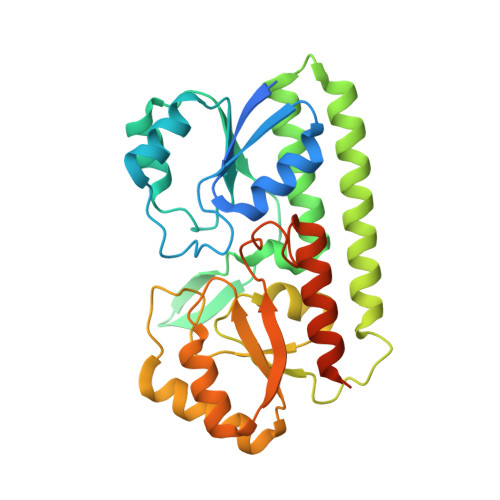Zinc acquisition and its contribution to Klebsiella pneumoniae virulence.
Maunders, E.A., Giles, M.W., Ganio, K., Cunningham, B.A., Bennett-Wood, V., Cole, G.B., Ng, D., Lai, C.C., Neville, S.L., Moraes, T.F., McDevitt, C.A., Tan, A.(2023) Front Cell Infect Microbiol 13: 1322973-1322973
- PubMed: 38249299
- DOI: https://doi.org/10.3389/fcimb.2023.1322973
- Primary Citation of Related Structures:
8SVC - PubMed Abstract:
Klebsiella pneumoniae is a World Health Organization priority pathogen and a significant clinical concern for infections of the respiratory and urinary tracts due to widespread and increasing resistance to antimicrobials. In the absence of a vaccine, there is an urgent need to identify novel targets for therapeutic development. Bacterial pathogens, including K. pneumoniae , require the d -block metal ion zinc as an essential micronutrient, which serves as a cofactor for ~6% of the proteome. During infection, zinc acquisition necessitates the use of high affinity uptake systems to overcome niche-specific zinc limitation and host-mediated nutritional immunity. Here, we report the identification of ZnuCBA and ZniCBA, two ATP-binding cassette permeases that are highly conserved in Klebsiella species and contribute to K. pneumoniae AJ218 zinc homeostasis, and the high-resolution structure of the zinc-recruiting solute-binding protein ZniA. The Znu and Zni permeases appear functionally redundant with abrogation of both systems required to reduce K. pneumoniae zinc accumulation. Disruption of both systems also exerted pleiotropic effects on the homeostasis of other d -block elements. Zinc limitation perturbed K. pneumoniae cell morphology and compromised resistance to stressors, such as salt and oxidative stress. The mutant strain lacking both systems showed significantly impaired virulence in acute lung infection models, highlighting the necessity of zinc acquisition in the virulence and pathogenicity of K. pneumoniae .
- Department of Microbiology and Immunology, The Peter Doherty Institute for Infection and Immunity, University of Melbourne, Melbourne, VIC, Australia.
Organizational Affiliation:


















